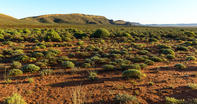Going to Extend
The indigenous people of Namaqualand always came second with regards to land rights. This subjugation began with the farmers and was continued by the mines. In the far north of the territory, however, the natives were getting restless.

As early as 1842, a memorandum was presented to the government by the Steinkopf missionaries on behalf of the local people. This was occasioned by rumours that the colony was going to extend its border to the Orange, thereby including this formerly ‘unclaimed’ part of the country.
The government confidently replied that there were no plans to move the boundary ‘or of interfering with the rights of those inhabiting the country beyond the boundary, by granting those lands to colonial farmers.’ Despite these calming words, land beyond the frontier had already been granted to farmers, starting from around 1776, and no formal ‘ticket of occupation’ was issued.
Annexation of Northern Namaqualand
In 1846, new rumours about the annexation of northern Namaqualand started bubbling up from the Cape. This time, there was some consultation with the local chiefs about the plans, one of whom commented that ‘what the great chief or governor does, I cannot object to; but this only I say, that I will keep my ground, for me and my people, in order to lead a quiet and honest life’.
In 1847, the border was indeed moved north to the Orange but no official government officers were installed, leaving the missionaries and the chiefs to go about their business in the usual way. Nevertheless, it was an uncertain time. In 1851, Rev. Brecher of the Steinkopf mission wrote to the government requesting clarity regarding the land rights of the indigenous people in the area.
He noted that ‘the chiefs and natives residing here wish to be placed under the protection of the British Government, and that the ground occupied by them may be reserved for their occupancy against the encroachments of farmers, traders, or any others wishing to settle on the same, as much unpleasantness has already arisen on this point.’
Vague Promises

In reply to this entreaty, the Colonial Secretary wrote back, saying the government would not ‘countenance any encroachments on the land occupied by the people of the institutions…nor has His Excellency any desire to disturb them in his occupancy’. However, the desired ticket of occupation was still not granted to the indigenous people of Steinkopf, and tenure on their ancestral land was not guaranteed beyond these vague promises.
The matter came to a head in 1853, at the start of the copper boom, when the Namaqua Mining Company applied to the government for a lease on a promising mining centre at Tweefontein (later Concordia).
This lease was happily granted but, when the first miners arrived, they were greeted with a letter from Rev. Brecher which pointed out that their new mine was actually located within the mission’s grounds. Speaking on behalf of the local people, Brecher went on to say that the land was protected by the government’s previous letter which had promised not to countenance any encroachment etc.
Self-Serving
Unwilling to start a ruckus, the Namaqua Mining Company signed a deal with the Steinkopf office bearers which granted them exclusive mineral rights over the ground in exchange for £100. The company then wrote to the government asking them about the legality of the whole situation, as they didn’t want to pay twice.
The reply was, predictably, self-serving. As far as the government was concerned, they had only guaranteed that the people of Steinkopf would not be ejected from the land, which was now said to be the property of the crown by virtue of the same letter of ‘protection’ mentioned by Brecher.
As such, the government retained all mineral rights to the area and said that any deal entered into between the company and the Steinkopf mission had nothing to do with them. The people of Steinkopf, however, didn’t realise that their appeal for protection had been opportunistically interpreted as a sign of ceding the land to the government. No prizes for guessing whose version of events won out in the end…
Occupational Rights
Nevertheless, the government did graciously agree that the indigenous people should be compensated for the ‘use of land in respect of water and pasturage’. The Namaqua Mining Company subsequently concluded an agreement with Steinkopf for water and grazing rights, on condition that no alcohol was to be sold within mission lands.
This uncomfortable division between the occupational rights of indigenous people and the mineral rights to the land on which they lived was only finalised when the ‘Mission Stations and Communal Reserves Act of 1909’ was passed. This piece of legislation explicitly ‘prohibited the “natives” of the territory from any legal claims to mineral rights on the land which was reserved for them’.
As a result of this policy, the local people did not derive any direct benefit from the mining industry that came to dominate the region. The only way they could make money from all the activity was by taking up employment on the mines, or by selling supplies to the mines. Charles Bell, surveyor-general of the colony, believed that this was only fair and fitting.
As he wrote in the 1850s: "I asked (the indigenous people) if they were fit to open all the mines…or whether they could smelt and work up and use the copper themselves. The reply usually was ‘no, no; take the copper, we can’t raise it, and don’t want it.’ … You say you apprehend oppression; rest quiet…Are the present prices you receive for labour, for the carriage of ore, and for your crops, symptomatic of oppression?
I think not, but your waste of these prices…in folly and vice, to the destruction of yourselves and your oxen, is an oppression from which no government can effectually shield you. And if, hereafter, your sons have difficulty in finding healthy and respectable wives of their own race, you will recollect, with bitterness, the drink, food, clothing, or indifference that induced you to shut your eyes while your daughters tempted the crowds of single men now landing on your coast."
By David Fleminger